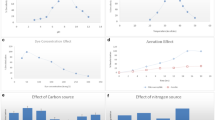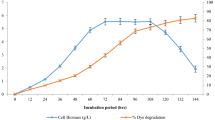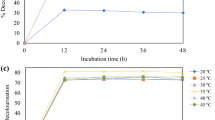Abstract
The present study investigated biodegradation and removal of Reactive Red 198 (RR198) dye from aqueous environments using a new bacterial consortium isolated from textile wastewater sludge on laboratory scale via batch study. Two bacterial species, Enterococcus faecalis (EF) and Klebsiella variicola (KV), were identified after isolation, through biochemical assays, Polymerase chain reaction (PCR), and 16S rRNA gene sequencing. To determine their ability to biodegrade RR198 dye, physicochemical parameters, including bacterial concentration, time, pH, and temperature, were tested; the results showed that the best conditions included a bacterial concentration of 3.5 mL × 105 cells/mL and incubation time of 72 h. Under such conditions, the removal efficiency of RR198 dye at an initial concentration of 10–25 mg/L was more than 98%; however, for concentrations of 50, 75, and 100 mg/L, removal efficiency was reduced to 55.62%, 25.82%, and 15.42%, respectively (p = 0.005). The highest removal efficiency occurred at pH 8.0, reaching 99.26% after 72 h of incubation. With increasing the incubation temperature from 25 °C to 37 °C, removal efficiency increased from 71.71 to 99.26% after 72 h of incubation, and increasing the temperature from 37 to 45 °C, the removal efficiency was reduced (p ≤ 0.001). Therefore, the EF–KV bacterial consortium can be used for efficient removal of RR198 dye from textile effluent.






Similar content being viewed by others
Abbreviations
- RR198:
-
Reactive red 198
- EF :
-
Enterococcus faecalis
- KV :
-
Klebsiella variicola
- PCR:
-
Polymerase chain reaction
- TSB:
-
Tryptic soy broth
- SDS:
-
Sodium dodecyl sulfate
- PBS:
-
Phosphate buffered saline
- ANOVA:
-
One-way analysis of variance
- BC:
-
Bacterial concentration
References
Afzal AM, Rasool MH, Waseem M, Aslam B (2017) Assessment of heavy metal tolerance and biosorptive potential of Klebsiella variicola isolated from industrial effluents. AMB Express 7:184
Brillas E, Martínez-Huitle CA (2015) Decontamination of wastewaters containing synthetic organic dyes by electrochemical methods. An updated review. Appl Catal B 166:603–643
Crini G, Badot P-M (2008) Application of chitosan, a natural aminopolysaccharide, for dye removal from aqueous solutions by adsorption processes using batch studies: a review of recent literature. Prog Polym Sci 33:399–447
Das A, Osborne JW (2017) Enhanced bioremoval of lead by earthworm–Lumbricus terrestris co-cultivated with bacteria–Klebsiella variicola. J Photochem Photobiol B: Biol 175:65–72
Dos Santos AB, Cervantes FJ, van Lier JB (2007) Review paper on current technologies for decolourisation of textile wastewaters: perspectives for anaerobic biotechnology. Bioresour Technol 98:2369–2385
Eslami H, Ehrampoush MH, Ghaneian MT, Mokhtari M, Ebrahimi A (2017a) Effect of organic loading rates on biodegradation of linear alkyl benzene sulfonate, oil and grease in greywater by integrated fixed-film activated sludge (IFAS). J Environ Manage 193:312–317
Eslami H, Samaei MR, Shahsavani E, Ebrahimi AA (2017b) Biodegradation and fate of linear alkylbenzene sulfonate in integrated fixed-film activated sludge using synthetic media. Desalin Water Treat 92:128–133. https://doi.org/10.5004/dwt.2017.21432
Eslami H, Sedighi Khavidak S, Salehi F, Khosravi R, Fallahzadeh R, Peirovi R, Sadeghi S (2017c) Biodegradation of methylene blue from aqueous solution by bacteria isolated from contaminated soil. J Adv Environ Health Res 5:4–6
Eslami H, Ehrampoush MH, Falahzadeh H, Hematabadi PT, Khosravi R, Dalvand A, Esmaeili A, Taghavi M, Ebrahimi AA (2018a) Biodegradation and nutrients removal from greywater by an integrated fixed-film activated sludge (IFAS) in different organic loadings rates. AMB Express 8:1–8. https://doi.org/10.1186/s13568-017-0532-9
Eslami H, Ehrampoush MH, Esmaeili A, Ebrahimi AA, Salmani MH, Ghaneian MT, Falahzadeh H (2018b) Efficient photocatalytic oxidation of arsenite from contaminated water by Fe2O3-Mn2O3 nanocomposite under UVA radiation and process optimization with experimental design. Chemosphere 207:303–312
Eslami H, Ehrampoush MH, Esmaeili A, Salmani MH, Ebrahimi AA, Ghaneian MT, Falahzadeh H, Fard RF (2019) Enhanced coagulation process by Fe-Mn bimetal nano-oxides in combination with inorganic polymer coagulants for improving As(V) removal from contaminated water. J Clean Prod 208:384–392
Esmaeili A, Kalantari M (2012) Bioremoval of an azo textile dye, Reactive Red 198, by Aspergillus flavus. World J Microbiol Biotechnol 28:1125–1131
Franciscon E, Grossman MJ, Paschoal JAR, Reyes FGR, Durrant LR (2012) Decolorization and biodegradation of reactive sulfonated azo dyes by a newly isolated Brevibacterium sp. strain VN-15. SpringerPlus 1:37
Gutowska A, Kałużna-Czaplińska J, Józ W (2007) Degradation mechanism of reactive orange 113 dye by H2O2/Fe2+ and ozone in aqueous solution. Dyes Pigm 74:41–46
Inaloo KD, Naddafi K, Mesdaghinia A, Nasseri S, Nodehi RN, Rahimi A (2011) Optimization of operational parameters for decolorization and degradation of CI Reactive Blue 29 By Ozone. Iran J Environ Health Sci Eng 8:227
Jadhav S, Kalme S, Govindwar S (2008) Biodegradation of methyl red by Galactomyces geotrichum MTCC 1360. Int Biodeterior Biodegrad 62:135–142
Joshi T, Iyengar L, Singh K, Garg S (2008) Isolation, identification and application of novel bacterial consortium TJ-1 for the decolourization of structurally different azo dyes. Bioresour Technol 99:7115–7121
Junnarkar N, Murty DS, Bhatt NS, Madamwar D (2006) Decolorization of diazo dye Direct Red 81 by a novel bacterial consortium. World J Microbiol Biotechnol 22:163–168
Kant R (2012) Textile dyeing industry an environmental hazard. Nat Sci 4:22–26
Kaur S, Singh V (2007) TiO 2 mediated photocatalytic degradation studies of Reactive Red 198 by UV irradiation. J Hazard Mater 141:230–236
Khan H, Ahmad N, Yasar A, Shahid R (2010) Advanced oxidative decolorization of Red Cl-5B: effects of dye concentration, process optimization and reaction kinetics. Pol J Environ Stud 19:83–92
Khan R, Bhawana P, Fulekar M (2013) Microbial decolorization and degradation of synthetic dyes: a review. Rev Environ Sci Biotechnol 12:75–97
Khosravi R, Eslami H, Zarei A, Heidari M, Baghani AN, Safavi N, Mokammel A, Fazlzadeh M, Adhami S (2018) Comparative evaluation of nitrate adsorption from aqueous solutions using green and red local montmorillonite adsorbents. Desalin Water Treat 116:119–128
Krishnan J, Kishore AA, Suresh A, Madhumeetha B, Prakash DG (2017) Effect of pH, inoculum dose and initial dye concentration on the removal of azo dye mixture under aerobic conditions. Int Biodeterior Biodegrad 119:16–27
Kurade MB, Waghmode TR, Jadhav MU, Jeon B-H, Govindwar SP (2015) Bacterial–yeast consortium as an effective biocatalyst for biodegradation of sulphonated azo dye Reactive Red 198. RSC Adv 5:23046–23056
Kurade MB, Waghmode TR, Patil SM, Jeon B-H, Govindwar SP (2017) Monitoring the gradual biodegradation of dyes in a simulated textile effluent and development of a novel triple layered fixed bed reactor using a bacterium-yeast consortium. Chem Eng J 307:1026–1036
Lalnunhlimi S, Krishnaswamy V (2016) Decolorization of azo dyes (Direct Blue 151 and Direct Red 31) by moderately alkaliphilic bacterial consortium. Braz J Microbiol 47:39–46
Lim CK, Bay HH, Aris A, Majid ZA, Ibrahim Z (2013) Biosorption and biodegradation of Acid Orange 7 by Enterococcus faecalis strain ZL: optimization by response surface methodological approachm. Environ Sci Pollut Res 20:5056–5066
Mahmoodi NM, Arami M, Limaee NY (2006) Photocatalytic degradation of triazinic ring-containing azo dye (Reactive Red 198) by using immobilized TiO2 photoreactor: bench scale study. J Hazard Mater 133:113–118
Mahmoodi NM, Hayati B, Arami M, Lan C (2011) Adsorption of textile dyes on pine cone from colored wastewater: kinetic, equilibrium and thermodynamic studies. Desalination 268:117–125
Mate MS, Pathade G (2012) Biodegradation of CI Reactive Red 195 by Enterococcus faecalis strain YZ66. World J Microbiol Biotechnol 28:815–826
Mathew S, Madamwar D (2004) Decolorization of ranocid fast blue dye by bacterial consortium SV5. Appl Biochem Biotechnol 118:371–381
Maulin PS, Kavita AP, Sunu SN, Darji A (2013) Bioremoval of Azo dye Reactive Red by Bacillus spp. ETL-1982. J Bioremediat Biodegrad 4:1–5
Maulin PS, Patel KA, Nair SS, Darji A (2016) Microbial degradation and decolorization of reactive dyes by Bacillus spp. ETL-1979. Am J Microbiol Res 2:16–23
Moussavi G, Mahmoudi M (2009) Degradation and biodegradability improvement of the reactive red 198 azo dye using catalytic ozonation with MgO nanocrystals. Chem Eng J 152:1–7
Nilsson I, Möller A, Mattiasson B, Rubindamayugi M, Welander U (2006) Decolorization of synthetic and real textile wastewater by the use of white-rot fungi. Enzyme Microb Technol 38:94–100
Nwankwegu AS, Ikpe EM, Chukwura EI, Irondi C, Obika EI (2016) Ex situ biodegradation of crude oil using bacterial isolates from palm oil mill effluent. American J Life Sci 4:71–75
Oller I, Malato S, Sánchez-Pérez J (2011) Combination of advanced oxidation processes and biological treatments for wastewater decontamination—a review. Sci Total Environ 409:4141–4166
Pandey A, Singh P, Iyengar L (2007) Bacterial decolorization and degradation of azo dyes. Int Biodeterior Biodegrad 59:73–84
Pandey AK, Sarada DV, Kumar A (2016) Microbial decolorization and degradation of reactive red 198 azo dye by a newly isolated Alkaligenes species. Proc Natl Acad Sci India Sect A 86:805–815
Popli S, Patel UD (2015) Destruction of azo dyes by anaerobic–aerobic sequential biological treatment: a review. Int J Environ Sci Technol 12:405–420
Saadatjou N, Rasoulifard M, Heidari A (2009) Removal of Basic Red 46 using low-cost adsorbent of hardened paste of portland cement from contaminated water. J Color Sci Tech 2:221–226
Sahasrabudhe MM, Saratale RG, Saratale GD, Pathade GR (2014) Decolorization and detoxification of sulfonated toxic diazo dye CI Direct Red 81 by Enterococcus faecalis YZ 66. J Environ Health Sci Eng 12:151
Saratale R, Saratale G, Kalyani D, Chang J-S, Govindwar S (2009) Enhanced decolorization and biodegradation of textile azo dye Scarlet R by using developed microbial consortium-GR. Bioresour Technol 100:2493–2500
Saratale RG, Saratale GD, Chang J-S, Govindwar S (2011) Bacterial decolorization and degradation of azo dyes: a review. J Taiwan Inst Chem Eng 42:138–157
Shahi DH, Eslami H, Ehrampoosh MH, Ebrahimi A, Ghaneian MT, Ayatollah S, Mozayan MR (2013) Comparing the efficiency of Cyperus alternifolius and Phragmites australis in municipal wastewater treatment by subsurface constructed wetland. Pak J Biol Sci 16:379–384. https://doi.org/10.3923/pjbs.2013.379.384
Singh RL, Singh PK, Singh RP (2015) Enzymatic decolorization and degradation of azo dyes–A review. Int Biodeterior Biodegrad 104:21–31
Solís M, Solís A, Pérez HI, Manjarrez N, Flores M (2012) Microbial decolouration of azo dyes: a review. Process Biochem 47:1723–1748
Tapalad T, Neramittagapong A, Neramittagapong S, Boonmee M (2008) Degradation of congo red dye by ozonation. Chiang Mai J Sci 35:63–68
Tony BD, Goyal D, Khanna S (2009) Decolorization of textile azo dyes by aerobic bacterial consortium. Int Biodeterior Biodegrad 63:462–469
Velmurugan P, Kumar RV, Dhinakaran G (2011) Dye removal from aqueous solution using low cost adsorbent. Int J Environ Sci 1:1492
Wong PW, Teng TT, Nik Norulaini N (2007) Efficiency of the coagulation-flocculation method for the treatment of dye mixtures containing disperse and reactive dye. Water Qual Res J Can 42:54–62
Wu C-H (2009) Photodegradation of CI Reactive Red 2 in UV/TiO2-based systems: effects of ultrasound irradiation. J Hazard Mater 167:434–439
Yagub MT, Sen TK, Afroze S, Ang HM (2014) Dye and its removal from aqueous solution by adsorption: a review. Adv Colloid Interface Sci 209:172–184
Yang C, Li L, Shi J, Long C, Li A (2015) Advanced treatment of textile dyeing secondary effluent using magnetic anion exchange resin and its effect on organic fouling in subsequent RO membrane. J Hazard Mater 284:50–57
Acknowledgements
The present study is the outcome of a research project (Code: 5165) sponsored by the Environmental Science and Technology Research Center of the School of Public Health at Shahid Sadoughi University of Medical Sciences and Health Services. The authors acknowledge and thank the research center for its generous support.
Author information
Authors and Affiliations
Corresponding author
Ethics declarations
Conflict of interest
The authors declare that they have no conflict of interests.
Ethics approval
The ethical approval conducted in Shahid Sadoughi University of Medical Sciences and Health Services, Yazd, Iran with code IR.SSU.SPH.REC.1395.119.
Additional information
Publisher’s Note
Springer Nature remains neutral with regard to jurisdictional claims in published maps and institutional affiliations.
Rights and permissions
About this article
Cite this article
Eslami, H., Shariatifar, A., Rafiee, E. et al. Decolorization and biodegradation of reactive Red 198 Azo dye by a new Enterococcus faecalis–Klebsiella variicola bacterial consortium isolated from textile wastewater sludge. World J Microbiol Biotechnol 35, 38 (2019). https://doi.org/10.1007/s11274-019-2608-y
Received:
Accepted:
Published:
DOI: https://doi.org/10.1007/s11274-019-2608-y




